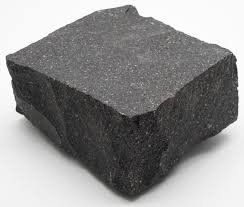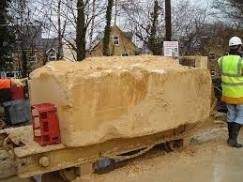Most common types of stone used by Stonemasons
Stonemasons work with stone such as limestone, sandstone, slate, marble, and granite, being the most popular/common.
Igneous:
Is the hardest and most durable of stones, like Basalt and Granite and are extremely difficult for stonemasons to use.
 These stones are more used for flooring, countertops, kerbstones, breakwaters, where they are industrially cut. The hardest stone frequently carved is granite,
at about 8 on the Mohs scale. An extremely difficult stone for stonemasons.
These stones are more used for flooring, countertops, kerbstones, breakwaters, where they are industrially cut. The hardest stone frequently carved is granite,
at about 8 on the Mohs scale. An extremely difficult stone for stonemasons.
Difficulty to carve:
Metamorphic:
Including Marble, which is easily carved and gives great definition/detail as it has a very fine texture.
 Slate is popular for memorials as it is hard wearing and fine grain is good for detailing letters.
Slate is popular for memorials as it is hard wearing and fine grain is good for detailing letters.
Difficulty to carve:
Sedimentary:
These are further sub-categorised into Limestones and Sandstones. Examples of Limestones are Bath stone and Portland, which have to be the most popular of stone used by stonemasons.
 Examples of Sandstones are Yorkstone and Sydneystone.
Examples of Sandstones are Yorkstone and Sydneystone. Limestone and sandstone, at about 4 on the Mohs scale, are the only sedimentary stones commonly carved.
Limestone and sandstone, at about 4 on the Mohs scale, are the only sedimentary stones commonly carved.
Difficulty to carve:
Stone use according to region
Due to the weight of stone, in historic terms it did not travel widely, there is and remains regional variation of stonework on buildings, according to their local stone quarry.
Per region:
- granite in Cornwall and parts of Wales
- limestone in a belt from Gloucestershire to Lincolnshire, including the Cotswolds
- slate in Cornwall and north-west Wales
- shale in mid-Wales (can’t do much with it, which is why in mid-Wales there are fewer stone buildings and more timber-framed buildings than elsewhere in Wales)
- sandstone in the Midlands and the North
- alabaster near Nottingham and in south Wales, near Barry (used for sculptures rather than buildings)
- flint in south-east England (flint is used in flint & lime buildings)
Durability:
Sedimentary stones, like Portland and Bath stone are susceptable to severe frosts or high concentrations of sulphur dioxide. So long as good stone detailing methods are employed this will give the best protection from surface water ingress, as they are permeable by water.
Mining/Quarrying process:
Blocks of stone are extracted using a method known as ‘stitch drilling’. A series of 30mm holes are drilled generally 150mm apart along the line required to be split. The stone is then broken along this line using a method known as ‘plug and feather’, which are wedges driven into metal guides in the hole.
After selection, the raw block is ‘primary sawn’. This transforms an uncut block into slices and is done with large circular saws that have diamond-tipped blades – cutting one slice at a time.
The block is cut into slices called ‘scants’. The thickness of the scant being equal to the course heights of the finished blocks, which in the case of the Beasts were 1.5 metres.
At the secondary saw the other four sides of the scants will be cut to the widths shown on the template drawings.